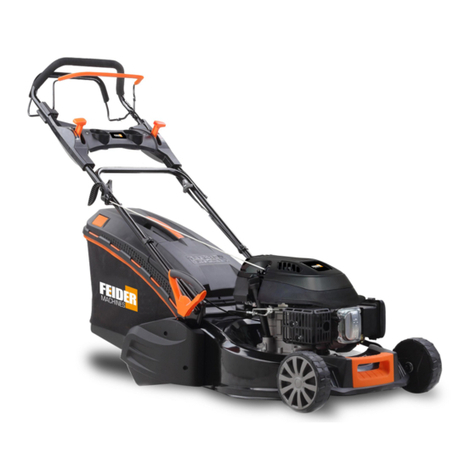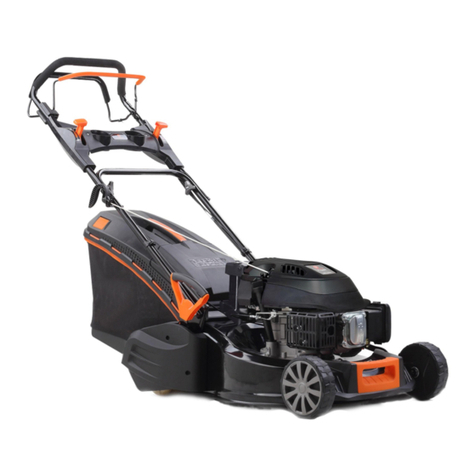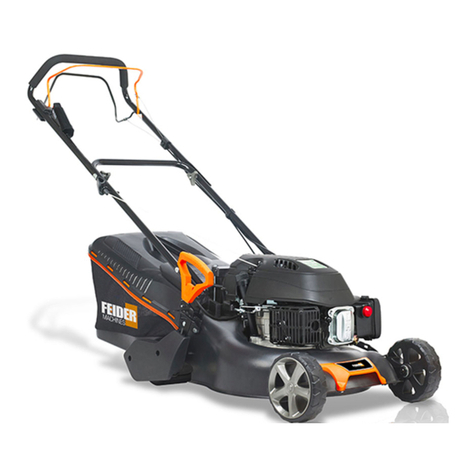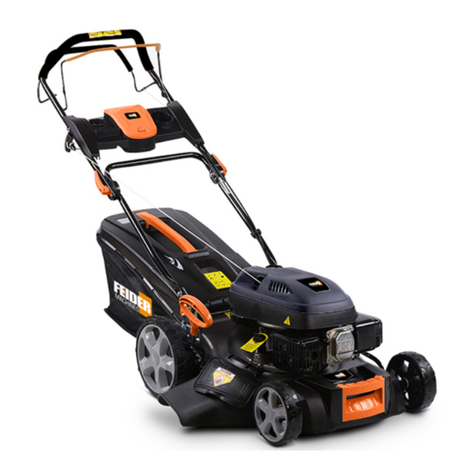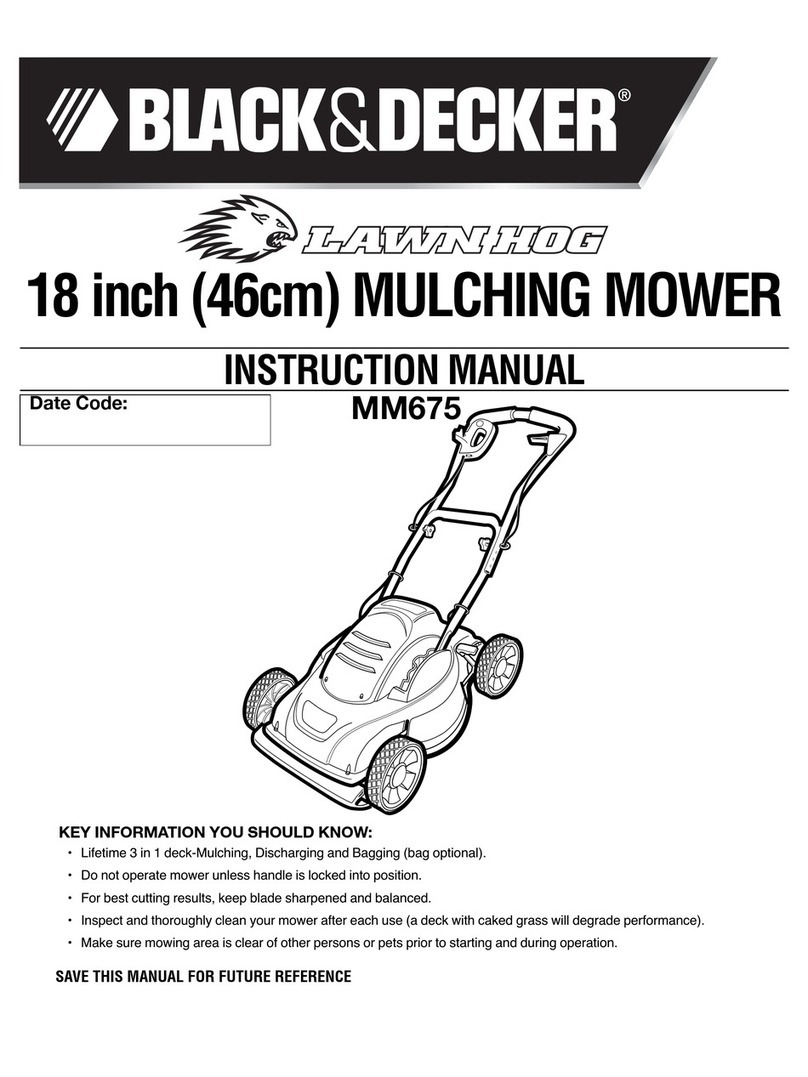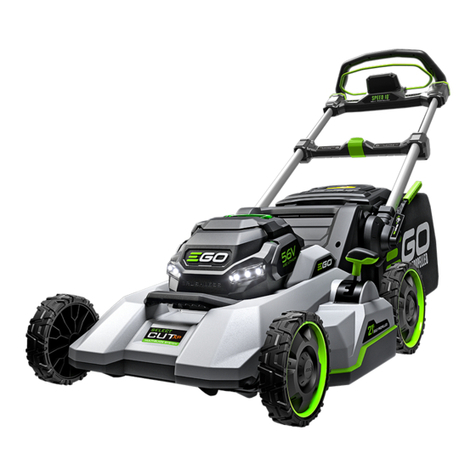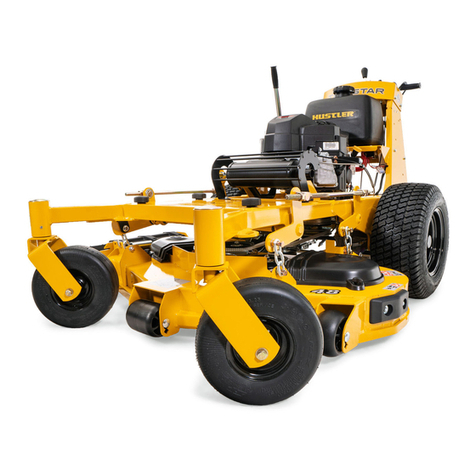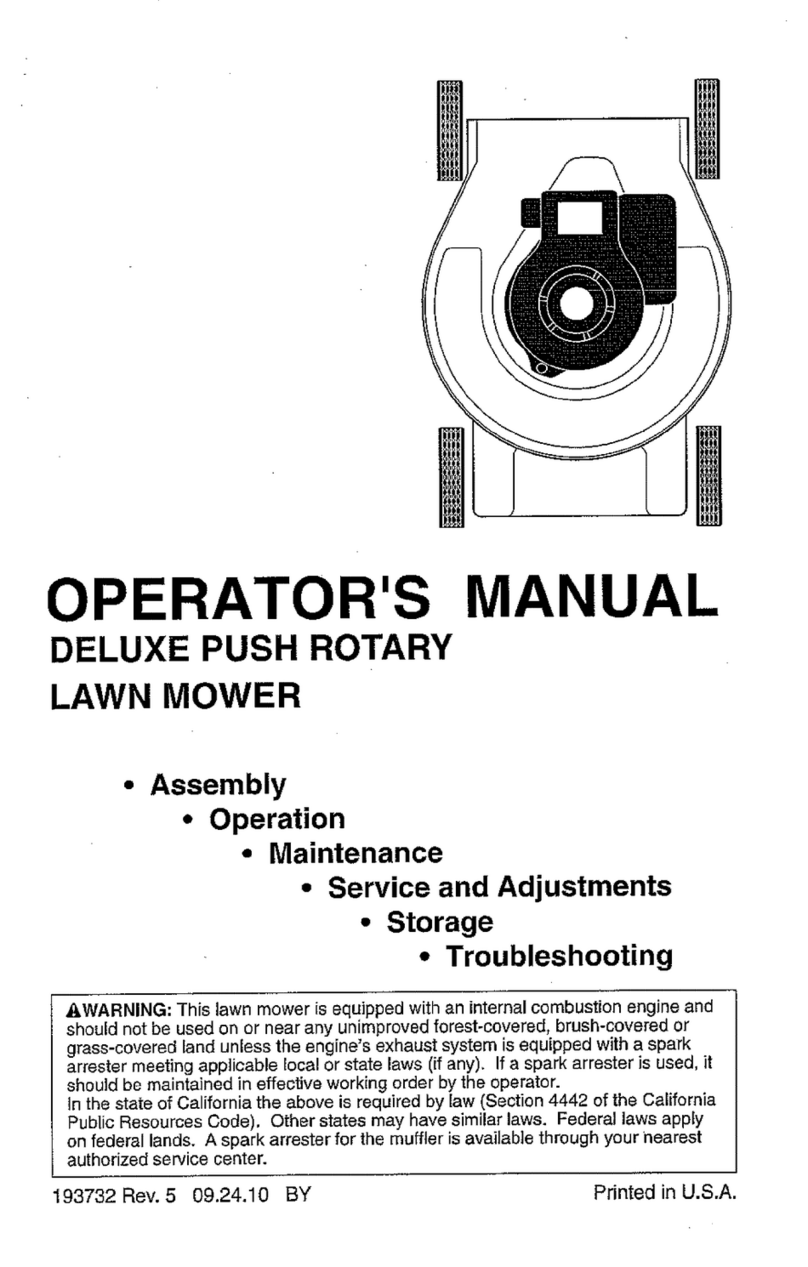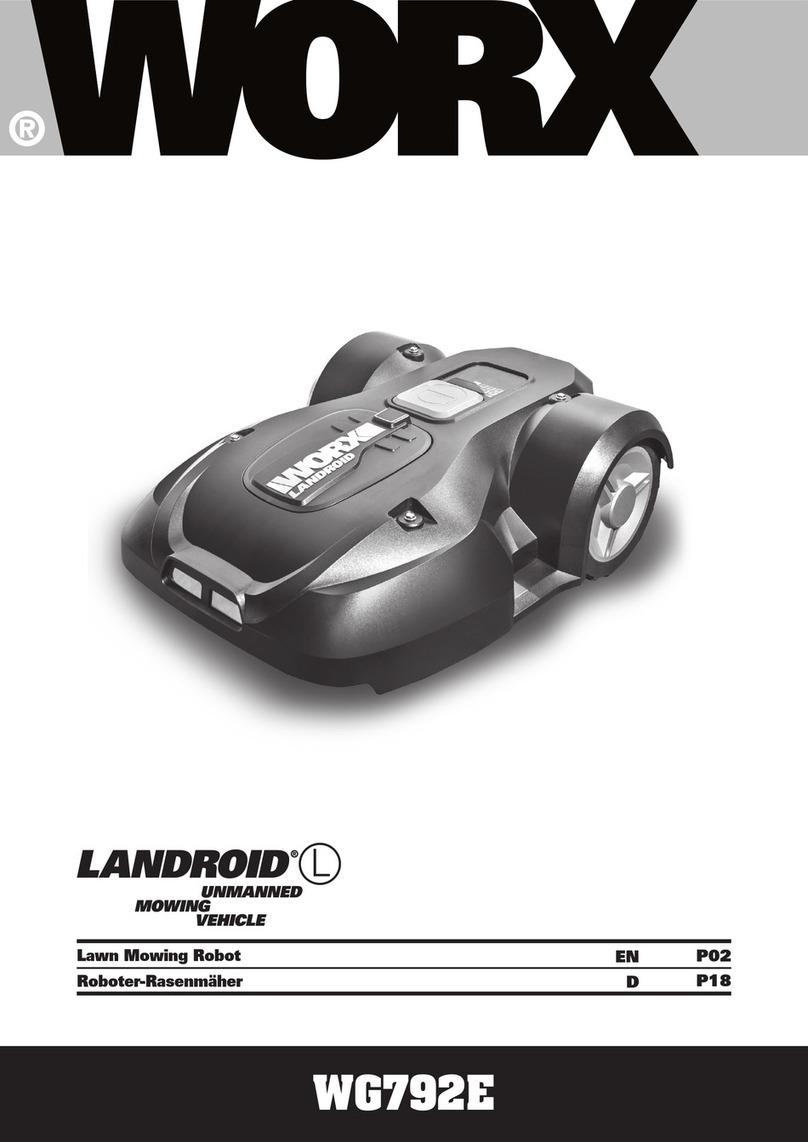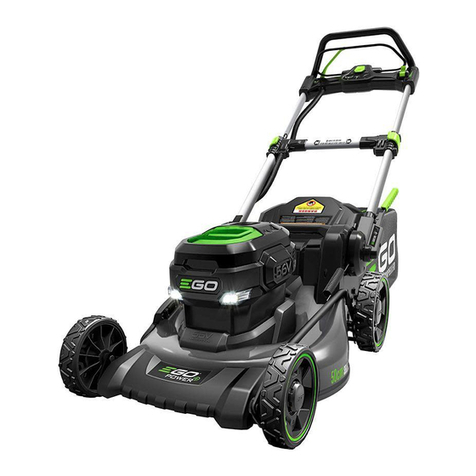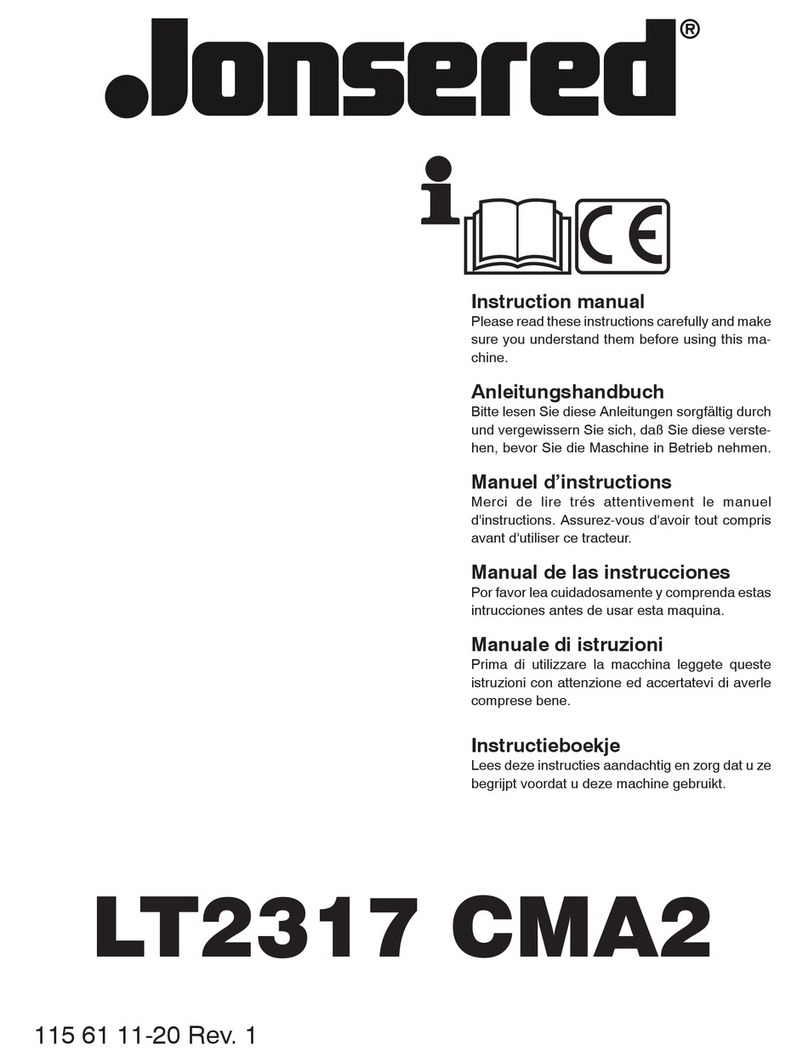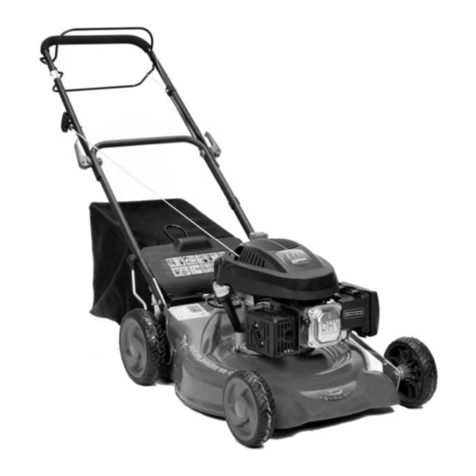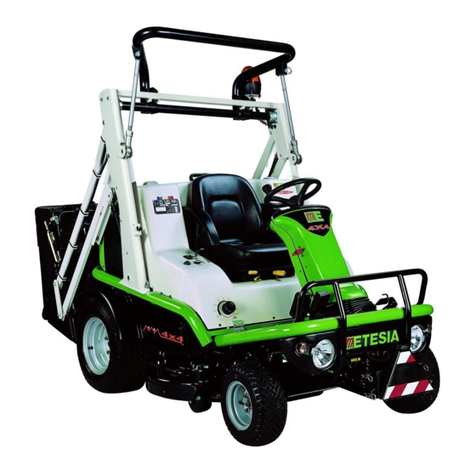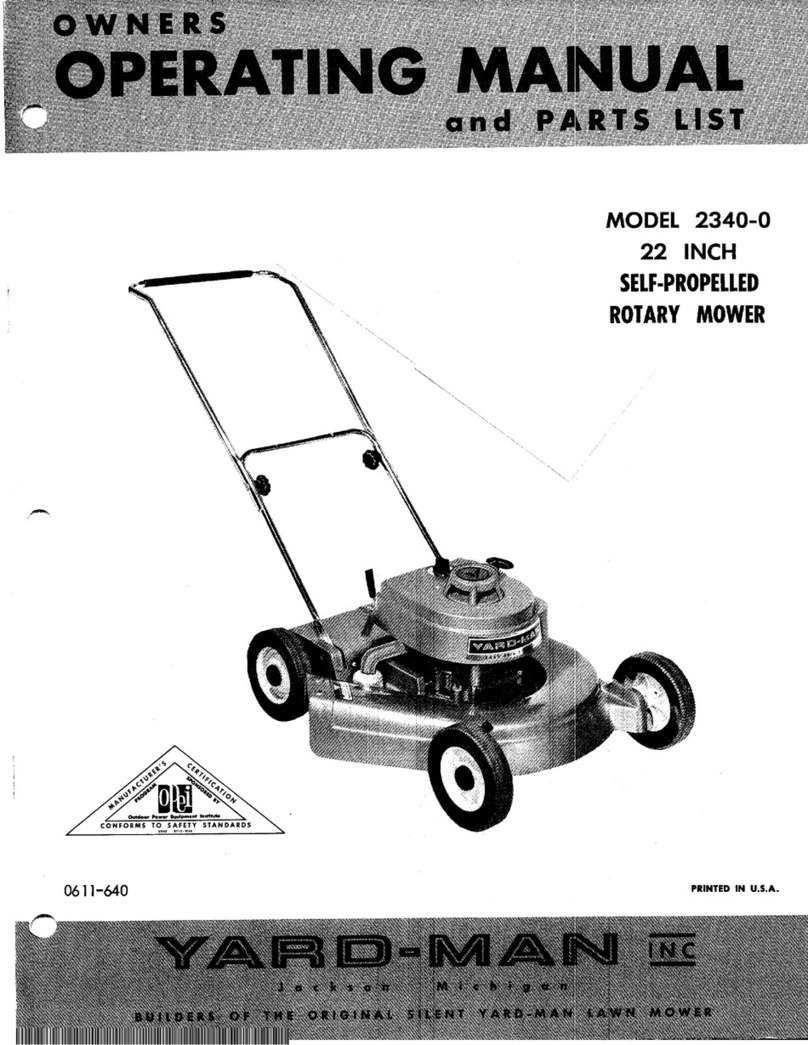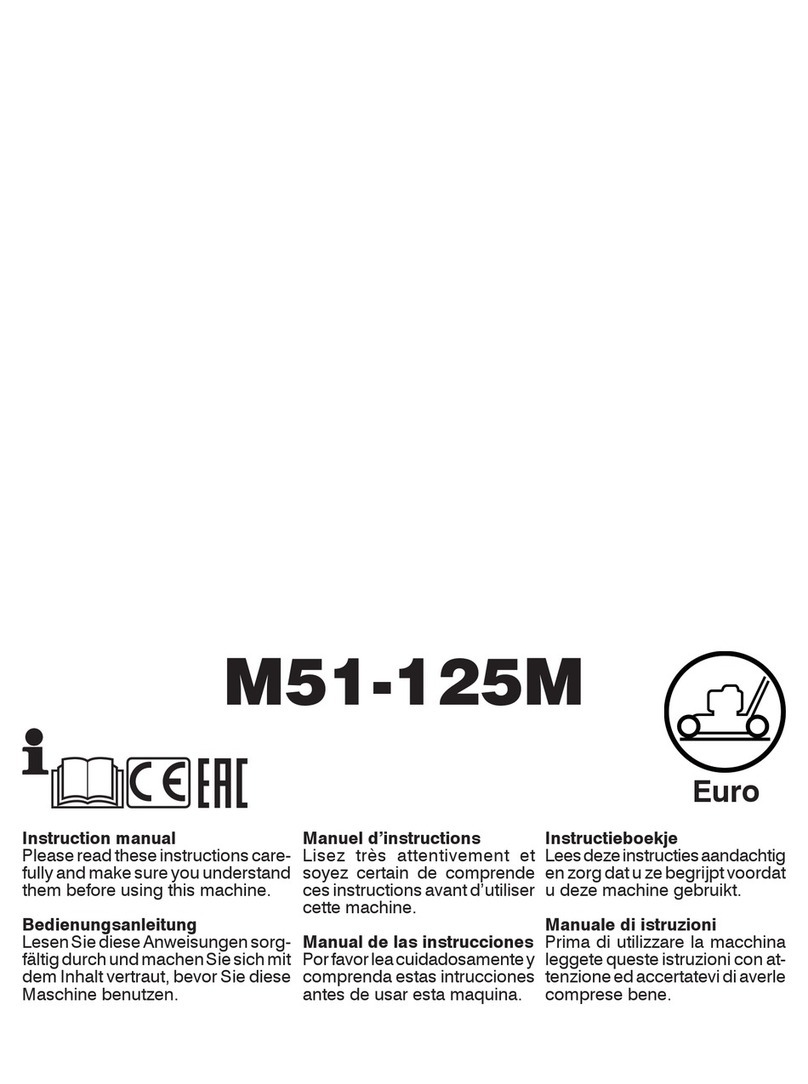Feider Machines FRT6224 User manual

ORIGINAL INSTRUCTIONS
RIDE-ON LAWN MOWER
FRT6224
USER GUIDE
CAUTION: Read this manual before using this machine!

Dear Customer,
Thank you for having chosen one of our products. We hope that you will get complete
satisfaction from using your new machine and that it will fully meet all your expectations.
This manual has been compiled in order that you may get to know your machine and to be
able to use it safely and efficiently. Don’t forget that it forms an integral part of the machine,
so keep it handy so that it can be consulted at any time and pass it on to the purchaser if
you resell the machine.
This new machine of yours has been designed and made in line with current regulations,
and is safe and reliable if used for cutting and collecting grass according to the
instructions given in this manual (proper usage). Using the machine in any other way or
ignoring the instructions for safe usage, maintenance and repair is considered "incorrect
usage"(☛5.1)which will invalidate the guarantee and the manufacturer will decline all
responsibility, placing the blame with the user for any damage or injury to himself or others
in such cases.
Since the product is continually being improved, you may find slight differences between
your machine and the descriptions contained in this manual. Certain modifications can be
made to the machine without prior warning and without the obligation to update the
manual, although the essential safety and function characteristics will remain unaltered. In
case of any doubts, do not hesitate to contact your Retailer. And now enjoy your work!
This manual gives all the necessary instructions for using the machine and the basic
maintenance that may be carried out by the user.
For any information not contained here, contact your Local Retailer or a Licensed Service
Centre.
If you wish, your Retailer will be pleased to offer maintenance programmed personalized
to your needs. This will enable you to keep your new acquisition in peak performance,
maintaining its value.
02

03
1. SAFETY ........................................................................................................................4
2. IDENTIFICATION OF THE MACHINE AND COMPONENTS.......................................9
3. UNPACKING AND ASSEMBLY .................................................................................10
4. CONTROLS AND INSTRUMENTS .............................................................................13
5. HOW TO USE THE MACHINE ....................................................................................16
6. MAINTENANCE .......................................................................................................... 27
7. ENVIRONMENTAL PROTECTION ............................................................................ 30
8. TROUBLESHOOTING................................................................................................ 31
9. ACCESSORIES ON REQUEST ................................................................................. 33
10. SPECIFICATIONS .................................................................................................... 34
11. DECLARATION OF CONFORMITY ..........................................................................35
12. WARRANTY ............................................................................................................. 36
13. PRODUCT FAILURE ...........................................................................................37
14. WARRANTY EXCLUSIONS ..................................................................................... 38

1.1 HOW TO READ THE MANUAL
This manual describes various versions of the machine, which mainly differ in:
– type of transmission: with either mechanical gear change or continuous speed
converter.
– the inclusion of components or accessories which may not be available in some areas;
– special equipment fitted.
The symbol highlights all the differences in usage and is followed by the
indication of the version that it refers to.
The symbol “☛” makes a reference to another part of the manual where further
information or clarification can be found.
Some paragraphs in the manual containing information of particular importance for safety
and operation are highlighted and signify the following:
These give details or further
information on what has already been said, and aim to prevent damage to the machine.
Non-observance will result in the risk of injury to oneself
or others.
Non-observance will result in the risk of serious injury or
death to oneself or others
Whenever a reference is made to a
position on the machine “front”, “back”, “left” or “right” side, this
is determined by facing the direction of forward travel.
For all usage and maintenance
operations on the engine or the battery which are not described
in this manual, consult the relevant manuals which form an integral
part of all the documentation supplied with the machine.
1.2 GENERAL SAFETY REGULATIONS
Read carefully before using the machine.
04

A) TRAINING
1) Read the instructions carefully. Be familiar with the controls and how to use the
equipment properly.
2) Never let children or people unfamiliar with these instructions use the machine. Local
regulations can restrict the age of the user.
3) Never mow while people, especially children, or pets are nearby.
4) Keep in mind that the operator or user is responsible for accidents or hazards occurring
to other people or their property.
5) Do not carry passengers.
6) All drivers should seek and obtain professional and practical instruction. Such
instruction should emphasize:
– the need for care and concentration when working with ride on machines;
– you cannot use the brake to regain control of a ride-on machine sliding down a slope.
The main reasons for loss of control are:
– insufficient wheel grip;
– over speeding;
– inadequate braking;
– the type of machine is unsuitable for its task;
– unawareness of the effect of ground conditions, especially slopes;
B) PREPARATION
1) While mowing, always wear sturdy footwear and long trousers. Do not operate the
equipment barefoot or wearing open sandals.
2) Thoroughly inspect the area where the equipment is to be used and remove all objects
which can be ejected from the machine.
3) DANGER! Petrol is highly flammable:
– store fuel in containers specifically designed for this purpose;
– refuel outdoors only and do not smoke while refueling;
– add fuel before starting the engine. Never remove the cap of the fuel tank or add petrol
while the engine is running or when the engine is hot;
– if you spill petrol, do not start the engine and move the machine away from the area of
spillage. Do not create any source of ignition until the petrol vapors have evaporated;
– put back and tighten all fuel tank and container caps securely.
4) Replace faulty silencers.
5) Before use, always visually inspect to see that the blade, blade bolts and cutter
assembly are not worn or damaged. Replace the worn or damaged blade and bolts in sets
to preserve the balance.
C) OPERATION
1) Do not start the engine in a confined space where dangerous carbon monoxide fumes
can collect.
05

2) Mow only in daylight or good artificial light.
3) Before starting the engine, disengage the blades and shift into neutral.
4) Do not use on slopes of more than 10° (17%).
5) Remember there is no such thing as a “safe” slope.
Travelling on grass slopes requires particular care. To guard against overturning:
– do not stop or start suddenly when going up or downhill;
– engage the drive slowly and always keep the machine in gear, especially when
travelling downhill;
– machine speeds should be kept low on slopes and during tight turns;
– stay alert for humps and hollows and other hidden hazards;
– never mow across the face of the slope.
6) Stop the blade from rotating before crossing surfaces other than grass.
7) Never use the machine with damaged guards, or without the safety protective devices
in place.
8) Do not change the engine governor settings or over speed the engine. Operating the
engine at excessive speed can increase the risk of personal injury.
9) Before leaving the driving seat:
– disengage the blades and lower the attachments;
– go into neutral and apply the parking brake;
– stop the engine and remove the ignition key (in the electric start models).
10) Disengage the blade, stop the engine and remove the ignition key (in the electric start
models):
– before clearing blockages or unclogging chutes;
– before cleaning, checking or working on the machine;
– after striking a foreign object. Inspect the machine for any damage and make repairs
before restarting and operating the equipment;
– If the machine starts to vibrate abnormally (inspect it immediately).
11) Disengage the blade when transporting or whenever it is not in use.
12) Stop the engine and disengage the blade:
– before refueling;
– before removing the grass-catcher.
13) Reduce the throttle setting before stopping the engine.
D) MAINTENANCE AND STORAGE
1) Keep all nuts, bolts and screws tight to be sure the equipment is in safe working
condition.
2) Never store the equipment with petrol in the tank inside a building where fumes may
reach an open flame or spark.
3) Allow the engine to cool before storing in any enclosure.
4) To reduce fire hazards, keep the engine, exhaust, battery compartment and petrol
storage area free of grass, leaves, or excessive grease.
5) Check the grass-catcher frequently for wear or deterioration.
6) Replace worn or damaged parts for safety purposes.
06

7) If the fuel tank has to be drained, this should be done outdoors.
8) When the machine is to be stored or left unattended, lower the cutting deck.
Improper maintenance can reduce life of the tool and create accident and damages.
Always bring maintenance.
the lawnmower safety systems or features shall not be tampered with or disabled;
the operator should not alter or tamper with any sealed adjustments for the engine speed
control;
Warning: there is a danger of moving blade assemblies during adjustment;
Use the tool only for the intended use as described in manual. Misuse will create
accidents and damages.
Warning: do not use the tool while being tired, ill or under influence of alcohol or other
drugs.
The lawnmower shall not be operated without either the entire grass catcher or
self-closing discharge opening guard in place”
It misses instructions regarding exposure to noise, selection and use of hearing protection,
including recommendations for limiting the duration of operation,
Prolonged use will expose the user to vibration which can affect health. Limit the duration
of operation and wear gloves.
Warning: Do not use of the lawnmower when there is a risk of lightning;
Residual risks
Even if you use this product in compliance with all safety requirements, the potential risks
of injury and damage remain. The following hazards may arise in the structure and design
of this product:
Always be vigilant when using this product, so you can recognize and manage the risks
rather.
There are adverse health consequences resulting from the emission of vibration if the
product is used for long periods of time or not properly managed and properly maintained.
There are risks of injury and property damage due to attachments or broken the sudden
impact of hidden objects when using cutting.
Risk of injury to persons and property caused by flying objects.
Prolonged use of this product exposes the operator to vibrations and can produce
so-called "white finger" disease. To reduce the risk, wear gloves and keep your hands
warm.
If any of the symptoms of "white finger syndrome" occur, seek immediate medical
attention.
Symptoms of "white finger" include numbness, loss of sensitivity, tingling, tingling, and
pain, loss of strength, color changes or skin condition. These symptoms usually appear on
the fingers, hands or wrists. Risk increases at low temperatures.
There is a risk of loss hearing in case of prolonged use and when a hearing protection is
not worn. Wear hearing protection.
Intended use
This model of thermal mower is designed for natural grass mowing. Any other use is
prohibited.
07

It is suitable only for private use in a garden or plot. Lawnmowers designed for private
plots or gardens are those used for the maintenance of grassy areas and private lawns
and should not be used in public areas, parks, sports, agricultural or forest areas.
1.3 SAFETY LABELS
Your machine must be used with care. Therefore, labels have been placed on the
machine to remind you pictorially of the main precautions to take during use. These labels
are to be considered an integral part of the machine. If a label should fall off or become
illegible, contact your Retailer to replace it. Their meaning is explained below.
Warning: Read the Operator’s Manual before operating this machine.
Warning (in the manual start models): disconnect the spark plug cap
and read the instructions before carrying out any maintenance or repairs.
Warning (in the electric start models): remove the key and read the
instructions before carrying out any maintenance or repairs.
Danger! Ejected objects: Keep bystanders away.
Danger! Dismemberment: Make sure that children stay clear of the
machine all the time when engine is running.
Danger! Ejected objects: Do not operate without the grass
catcher in place.
Danger! Machine rollover: Do not use this machine on slopes
greater then 10°
Danger of cutting yourself. Blade in movement. Do not put hands or
feet near or under the opening of the cutting plate.
Danger! Away from the danger of combustible substances
08

Danger! Do not near the operational machine
WARNING! Do not put hands or feet near rotating parts or under the
cutting deck. Contact with the blade(s) can amputate hands and feet.
Danger ! Electrical shock !
This symbol indicates the surface is very hot and not touching
Guaranteed sound power level
2.1 IDENTIFICATION OF THE MACHINE
The identification label located under the seat has the essential
data of each machine.
2.2 NAME AND ADDRESS OF MANUFACTURER
The machine is composed of a series of
main component
11. Cutting deck: this is the guard enclosing
the rotating blade
12. Blade: this is what cuts the grass. The
wings at the ends help convey the cut grass
towards the collector channel.
13. Collector channel: this is the part
connecting the cutting deck to the grass-catcher.
14. Grass-catcher: as well as collecting the grass cuttings, this is also a safety element in
that it stops any objects drawn up by the blade from being thrown outside of the machine.
15. Engine: this moves the blade and drives the wheels. Its specifications and regulations
for use are described in a specific manual.
16. Batteries (only in the electric start models): provides the energy for starting the
engine. Its specifications and regulations for use are described in a specific manual.
17. Driver seat: this is where the machine operator sits. It has a sensor which detects the
presence of the operator and acts as a safety device.
14
13
15
11
12
16
17
18
19
09

18. Labels for regulations and safety: give reminders on the main provisions for
working safely, each of which is explained in chapter 1.
19. Engine cover: for access to the engine
For storage and transport purposes, some components of the machine are not installed in
the factory and have to be assembled after unpacking. Follow the instructions below.
The machine is supplied without engine oil or fuel. Before
starting the engine, fill with oil and fuel following the instructions given in the engine
manual.
Unpacking and completing the assembly should be done
on a flat and stable surface, with enough space for machine handling and its
packaging, always making use of suitable equipment.
3.1 UNPACKING
When unpacking the machine, take care to gather all the individual parts, fittings and
documentation.
To avoid damaging the cutting deck when getting the
machine down from the pallet, take it to the maximum height and be very careful.
The supply includes:
– the battery;
– bolts and screws, necessary for completing the assembly;
– a syringe for draining the engine oil. (on request)
Disposal of the packaging should be done in accordance with the local
regulations in force.
3.2 FITTING THE STEERING WHEEL
Put the machine on a flat surface and straighten up the front
wheels.
1. fit the steering wheel(1)onto the protruding shaft (2)
and fasten it by impacting the included pin (3) into the hole (4),
1
2
3
4
10

3.3 FITTING THE SEAT
Fit the seat (1) onto the plate (2)
using the screws (3)
3.4 FITTING THE BLADE ENGAGEMENT LEVER
Fit the end of the lever (1) on the projecting part
of the pin (2) and fix it all by tightening the
screw (3) and nut (4)
3.5 CONNECTING THE BATTERY
1. Position the battery (1) in its compartment under the
seat;
2. Connect the battery connector (2) to the machine
connector (3);
3. Recharge the battery by following the instructions in the
Manual(☛6.2.3).
Never start the engine until the battery is fully charged!
Follow the battery manufacturer's instructions regarding
safe handling and disposal.
1
2
3
3
1
2
3
4
1
2
3
11

3.6 FITTING THE GRASS-CATCHER
Identify the screws to be used by following the drawing that shows them in
their actual Size
Fit the two tie rods (1) and fasten them
by using the screws (2)
3.7 FITTING THE DEFLECTOR
12

4.1 STEERING WHEEL
Turns the front wheels.
4.2 CLUTCH / BRAKE PEDAL
This pedal has a double function: during the first part of its travel it acts as a clutch,
engaging and disengaging drive to the wheels, and in the second part it works the brake.
Do not keep the pedal half
way of clutch engagement or disengagement, as
this can cause overheating and damage the
transmission belt
When the machine is in
movement, keep your foot
off the pedal.
4.1
4.2
4.3
4.4
4.5
4.11
4.12
4.6
4.6.1
13

4.3 PARKING BRAKE LEVER
This lever stops the machine from moving when it has been parked.
There are two positions:
4.3 PARKING BRAKE LEVER
This lever stops the machine from moving when it has been parked.
There are two positions:
–The brake is engaged by pressing the pedal (☛4.2)
right down and moving the lever to position «B».
When you take your foot off the pedal it will be
blocked by the lever in the down position.
– To disengage the parking brake, press the
pedal(☛4.2).The lever will return to position «A».
4.4 SPEED CHANGE LEVER
This lever has six positions for the four forward
gears, the neutral position «N», and reverse
«R».
– To change gear, press the pedal (☛4.2)
halfway down and move the lever as per
the indications on the label.
Reverse must be engaged when the machine has stopped.
4.5 CUTTING HEIGHT ADJUSTING LEVER
There are five positions for this lever, shown as
«1» to «5» on the plate, which correspond to
various cutting heights from 3.0 to 7.0 cm.
– To go from one position to another,
move the lever sideways and put it back in one
of the stop notches.
A
B
R
N
4
3
2
1
4.5
14

4.6 LEVER ENGAGEMENT AND BRAKE OF BLADE
The lever has two positions, as shown on the plate:
–If the blade is engaged when safety conditions have
not been complied with, the engine shuts down and
cannot be restarted ( ☛5.2).
– In disengaging the blade (Pos. «A»), a brake is
simultaneously activated which stops their rotation within a
few seconds.
4.11 KEY IGNITION SWITCH
This key operated control has three positions:
《stop》everything is switched off;
《on》activates all parts;
《start》engages the starter
On being released at the «START» position, the key will
automatically return to «ON».
4.12 ACCELERATOR LEVER
Regulates the engine's r.p.m. The positions are indicated on a plate showing the
following symbols :
4.6
A
B
4.11
4.12
15

«CHOKE» (if fitted) = cold starting
«FAST» for maximum engine speed
«SLOW» for minimum engine speed
–The «CHOKE» position (if fitted) enriches the mixture so must only be used for the
necessary time for cold starting.
– When moving from one area to another, put the lever in a position between «SLOW»
and «FAST».
– When cutting, go to the «FAST» position.
5.1 SAFETY RECOMMENDATIONS
The machine must only be used for the purpose for
which it was designed (cutting and collection of grass).
Using the machine in any other way is considered "improper use" which will
invalidate the warranty, relieve the manufacturer from all liabilities, and the user will
consequently be liable for all and any damage or injury to himself or others.
Examples of improper use may include, but are not limited to:
– transport people, children or animals on the machine or on a trailer;
– tow or push loads;
–use of the machine for moving over unstable, slippery, icy, stony, rough,
marshy ground and puddles that do not allow for evaluation of the consistency
of the ground;
– use of the machine for leaf or debris collection;
– use of the blades on surfaces other than grass
Do not tamper with or remove the safety devices
fitted to the machine. REMEMBER THAT THE USER IS ALWAYS RESPONSIBLE
FOR DAMAGE AND INJURIES TO OTHERS. Before using the machine:
–read the general safety regulations(
☛
1.2) , paying particular attention to
driving and cutting on slopes;
–carefully read the instructions for use, become familiar with the controls and on
how to quickly stop the blade and engine.
– never put your hands or feet next to or beneath the rotating parts and always keep
away from the discharge opening.
Do not use the machine when in a precarious state of health or under the effect of
medicines or other substances that can reduce your reflex actions and your ability
to concentrate. It is the user's responsibility to assess the potential risk of the area
where work is to be carried out, as well as to take all the necessary steps to ensure
16

his own safety and that of others, particularly on slopes or rough, slippery and
unstable ground. Do not leave the machine stopped on high grass with the engine
running to avoid the risk of starting a fire. Always lower the speed when changing
direction, especially on tight turns.
This machine must not be used on slopes greater than 10°
(17%) (
☛
5.5).
All the references relating to the positions of controls are
those described in chapter 4.
5.2 WHY THE SAFETY DEVICES CUT IN
The safety devices work in two ways:
– by preventing the engine from starting if all the safety requirements have not been met;
– by stopping the engine if even just one of the safety requirements is lacking.
a) The engine must only be started in the following conditions:
– the transmission is in “neutral”;
– the blade is not engaged;
– the operator is seated or the parking brake is engaged.
b) The engine stops when:
– the operator leaves his seat when the blade is engaged;
– the operator leaves his seat with a gear engaged;
– the grass-catcher is lifted without disengaging the blade;
– the blade is engaged without the grass-catcher in place;
– the parking brake is engaged without disengaging the blade;
– the speed change is activated (☛4.4) with the parking brake on.
5.3 PRELIMINARY OPERATIONS BEFORE STARTING WORK
These controls ensure that the work gives the best results and is done in maximum safety.
5.3.1 Seat adjustment
Adjust the seat by sliding it along the bracket slots.
1. Loosen the four screws (1);
2. once you have found the right
position, securely tighten the four
screws (1).
1
1
17

5.3.2 Tire pressure
Having the correct tire pressure is essential for ensuring that the cutting deck is perfectly
horizontal and thus mows evenly.
1. Unscrew the valve caps;
2. Connect a compressed air line with a gauge to the valves and adjust the pressure to the
indicated values.
3. Screw the valve caps back on.
5.3.3 Filling with oil and fuel
Refueling should be carried out in an open or
well-ventilated area with engine stopped. Always remember that petrol fumes are
inflammable. DO NOT TAKE A NAKED FLAME TO THE TANK’S OPENING
IN ORDERS TO SEE THE TANK’S CONTENTS AND DO NOT SMOKE WHEN
REFUELLING.
The type of oil and fuel to be used is given in
the engine manual.
With the engine stopped, check its oil level.
1. to reach the plug (1), remove the engine
cover (2) with the aid of a screwdriver
2. by closely following the methods described
in the engine manual, make sure the oil level is
between the MIN and MAX marks on the dipstick (3);
3. always refit the plug (1) and engine cover (2).
18

To refuel (to be done when the machine has stopped):
1. unscrew the plug (4) from the tank located behind the
seat;
2. refuel using a funnel, but do not completely fill the tank.
The tank's capacity is about 1.1 liters;
3. always refit the plug(4)
Do not drip petrol onto the
plastic parts to avoid ruining them. In the event of
accidental leaks, rinse immediately with water. The warranty does not cover for damage to
plastic parts of the bodywork or the engine caused by petrol.
5.3.4 Fitting the protections at the exit (grass catcher)
Never use the machine without having fitted the exit
protection!
Hook the grass-catcher (1) onto the brackets
(2) and centre it up with the rear plate, so that the two
reference marks (3) coincide.
5.3.5 Checking machine safety and efficiency
1. Check that the safety devices function as described(☛5.2).
2. Check that the brake is in perfect working order.
3. Do not start mowing if the blade vibrates or if you are unsure whether they are sharp
enough. Always remember that:
– A badly sharpened blade pulls at the grass and causes the lawn to turn yellow.
– A loose blade causes unwanted vibrations and can be dangerous.
Do not use the machine if you are unsure whether it is
working safely or efficiently. If in doubt, contact your Dealer immediately to make
the necessary checks and repairs
1
2
3
19

5.4 USING THE MACHINE
5.4.1 Starting the engine
all starting operations have to be effected in an open or
well-ventilated area! ALWAYS REMEMBER THAT EXHAUST GASES ARE TOXIC!
To start the engine:
1. sit on the seat and press the brake pedal right down(☛4.3);
2. put the transmission into neutral («N») (☛4.4);
3. disengage the blade (☛4.6);
4. for cold starting, put the accelerator lever in the «CHOKE»
position (if fitted) as shown on the label (☛4.12 ).
Alternatively, if the engine is still hot or without a choke, position the lever between
«SLOW» and «FAST»;
5. put in the key (☛4.11) and turn to «ON» to make electrical contact, then turn to
«START» to start the engine;
6. release the key once the engine has started;
The choke (if fitted) must be closed as soon as possible.
Using it when the engine is already warm can foul the spark plugs and cause the
engine to run erratically.
If you have difficulty starting, do not make several
attempts to avoid flooding the engine or running down the battery (if present).
– Check that the conditions allowing the engine to start are met
– Turn the key (electric start) to «OFF». Wait for a few seconds and repeat the start
operation. Should the malfunction persist, refer to chapter «8» of this manual and the
engine manual.
20
Table of contents
Other Feider Machines Lawn Mower manuals

Feider Machines
Feider Machines FTDT511ZT-A User manual
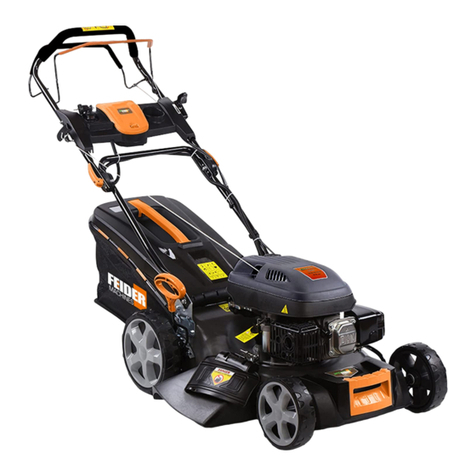
Feider Machines
Feider Machines FTDT5175ES User manual

Feider Machines
Feider Machines FTDT5170ZT User manual

Feider Machines
Feider Machines FTDT5070 User manual
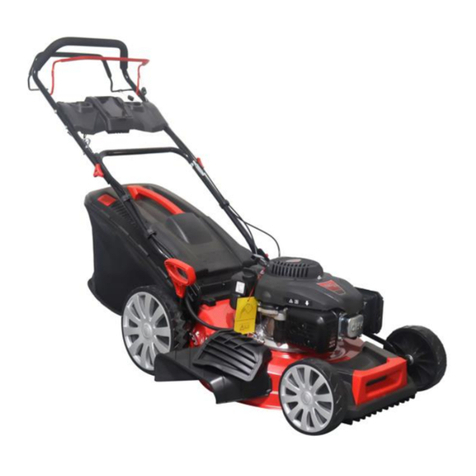
Feider Machines
Feider Machines FTDT5096ES User manual
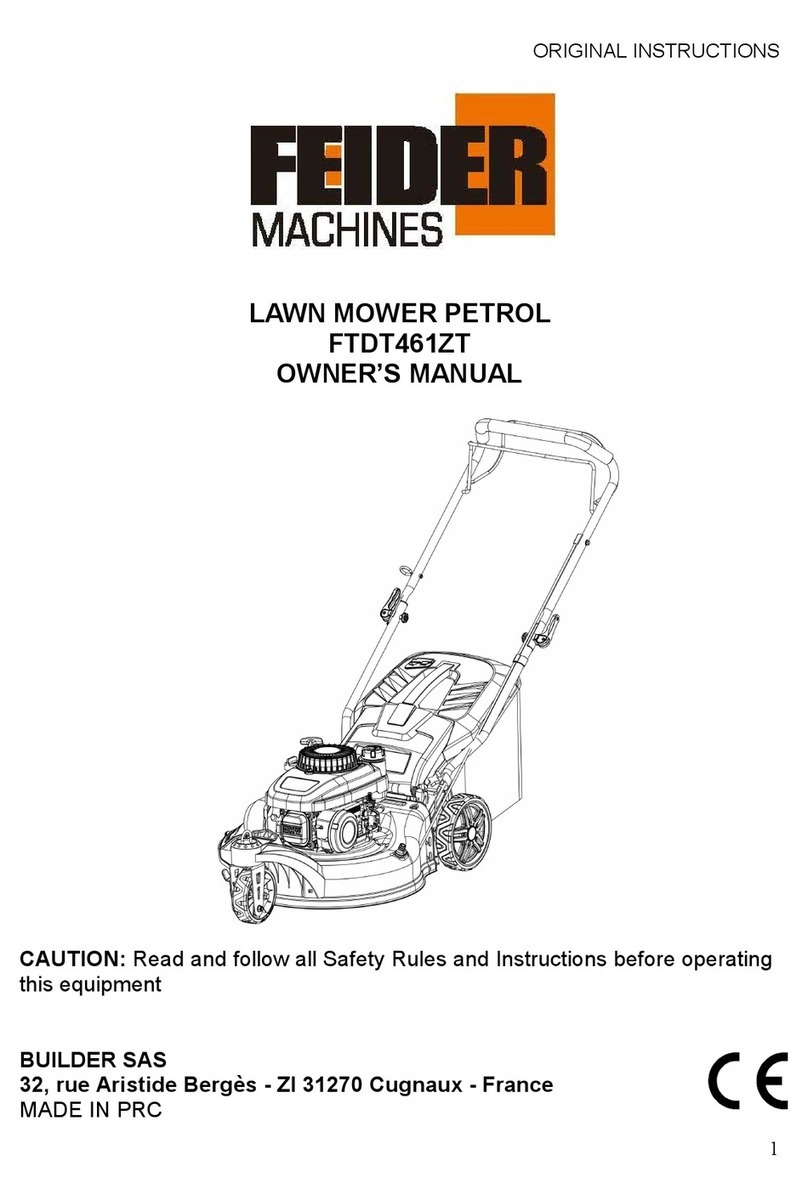
Feider Machines
Feider Machines FTDT461ZT User manual
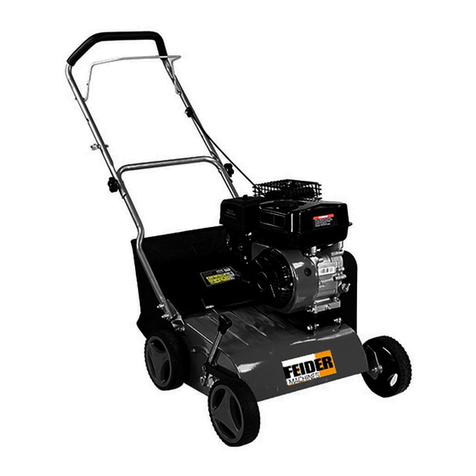
Feider Machines
Feider Machines FST212 User manual
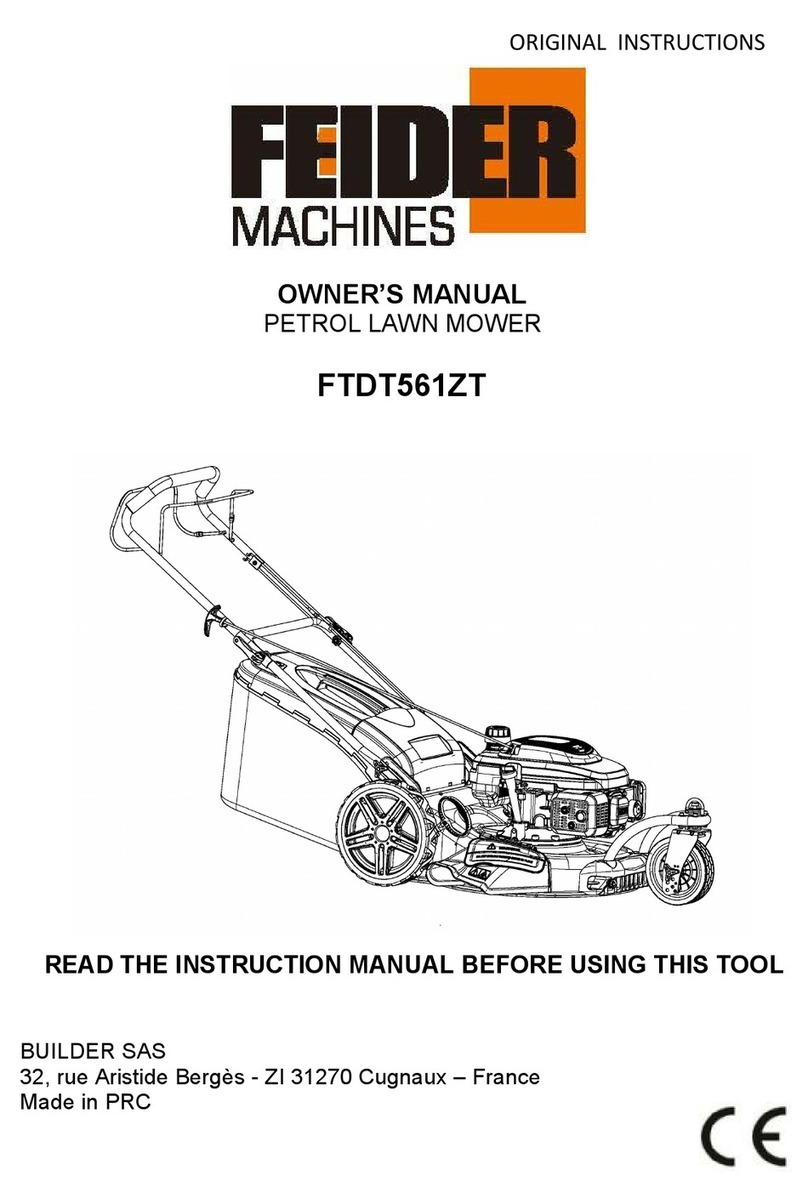
Feider Machines
Feider Machines FTDT561ZT User manual
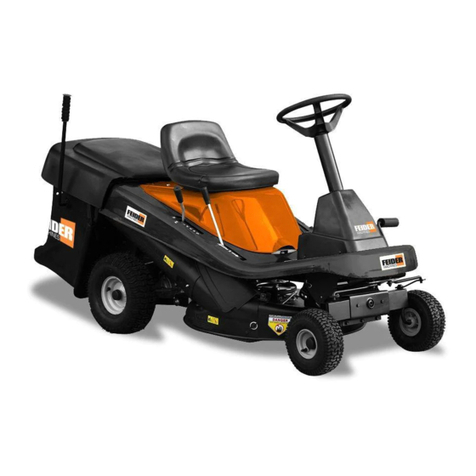
Feider Machines
Feider Machines FRT7550M Operation instructions
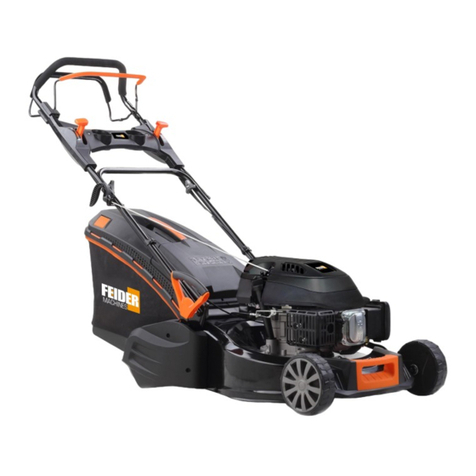
Feider Machines
Feider Machines FTDTR4870 User manual
